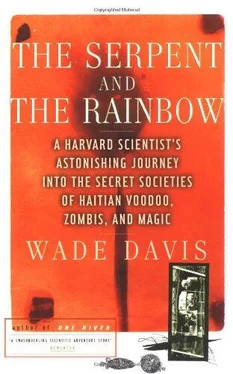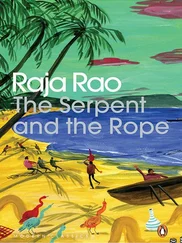Wade Davis - The Serpent and the Rainbow
Здесь есть возможность читать онлайн «Wade Davis - The Serpent and the Rainbow» весь текст электронной книги совершенно бесплатно (целиком полную версию без сокращений). В некоторых случаях можно слушать аудио, скачать через торрент в формате fb2 и присутствует краткое содержание. Год выпуска: 1985, Издательство: Simon & Schuster, Жанр: Старинная литература, на английском языке. Описание произведения, (предисловие) а так же отзывы посетителей доступны на портале библиотеки ЛибКат.
- Название:The Serpent and the Rainbow
- Автор:
- Издательство:Simon & Schuster
- Жанр:
- Год:1985
- ISBN:нет данных
- Рейтинг книги:5 / 5. Голосов: 1
-
Избранное:Добавить в избранное
- Отзывы:
-
Ваша оценка:
- 100
- 1
- 2
- 3
- 4
- 5
The Serpent and the Rainbow: краткое содержание, описание и аннотация
Предлагаем к чтению аннотацию, описание, краткое содержание или предисловие (зависит от того, что написал сам автор книги «The Serpent and the Rainbow»). Если вы не нашли необходимую информацию о книге — напишите в комментариях, мы постараемся отыскать её.
The Serpent and the Rainbow — читать онлайн бесплатно полную книгу (весь текст) целиком
Ниже представлен текст книги, разбитый по страницам. Система сохранения места последней прочитанной страницы, позволяет с удобством читать онлайн бесплатно книгу «The Serpent and the Rainbow», без необходимости каждый раз заново искать на чём Вы остановились. Поставьте закладку, и сможете в любой момент перейти на страницу, на которой закончили чтение.
Интервал:
Закладка:
This statement perfectly encapsulated the Victorians’ dilemma. At the root of the hysterical fear of premature burial was the fact that physicians recognized, and patients suffered, a number of peculiar conditions characterized by immobility and insensibility, and known variously as trance, catalepsy, cataplexy, and suspended animation. As far as the public was concerned, any one of these clinical diagnoses could be the ominous prelude to accidental interment. Victorian physicians noted that catalepsy was marked by the singular absence of will or volition; the body of the patient remained in whatever position it was placed. Trance was said to most nearly resemble the condition of a hibernating animal, with the patient suffering complete mental inertia. Cataplexy was a modification of the same conditions, only the patient simply collapsed limply to the ground with the eyes closed, completely immobile, unable to speak, yet conscious and totally aware of all that was going on around him. Medical writers of the era even discussed a fourth clinical condition, marked by immobility, which they termed ecstasy, but this was not a state that might lead to premature burial. The ecstatic patient was described typically as having a “radiant, visionary expression and a tendency to fix himself in statuesque poses whilst concentrating upon some object of adoration.”
Needless to say, these conditions are no longer recognized by the medical profession. Certain aspects of the cataleptic condition have been subsumed under “catatonic schizophrenia,” but trance has been reduced to a feature of hypnosis research, and ecstasy and cataplexy have disappeared as clinical diagnoses. But for the Victorians these ailments did exist, and they were discussed seriously by the leading medical authorities precisely because people were succumbing to them. Where did they come from? Cataplexy, for example, is described in the old medical textbooks as “being precipitated by strong emotion and persisting until such emotion be controlled,” which sounds not unlike another common feature of Victorian life, also now abandoned—the fainting spell. Recently some have suggested that women of the era simply suffered the physical consequences of wearing impossibly tight corsets, but this interpretation misses the point. Fainting was a socially conditioned response; in certain clearly recognized and predictable situations it was virtually expected. Young women of the elite, in particular, found fainting a convenient means to avoid or modify uncomfortable social predicaments. Some learned to attain their desires simply by cleverly faking, while others actually did pass out, and in some cases it was assumed by physicians that they were dead. In other words, a socially conditioned act became a physiological reality.
Like the fainting spell, catalepsy, cataplexy, trance, and ecstasy were socially conditioned ailments, and their cause lay somewhere deep within the psyche of the age. Their manifestations were concrete and isolated to a particular time. The fear of premature burial undoubtedly was accentuated because people really believed such states of sham death possible. And just because they did exist for the Victorians, some unfortunate souls may well have ended up in the ground wishing that their relatives had rented from Count Karnice-Karnicki.
Part of what was going on in Victorian England was related to a phenomenon that Western anthropologists had noted in “primitive” societies but overlooked in their own culture. For just as an individual’s sickness may have a psychosomatic basis, it is possible for a society to generate physical ailments and conditions that have meaning only in the minds of its people. In Australia, for example, aborigine sorcerers carry bones extracted from the flesh of giant lizards, and when these slivers are pointed at a person while a death spell is recited, the individual invariably sickens and almost always dies. According to one scientific report the victim
stands aghast, with his eyes staring at the treacherous pointer, and with his hands lifted as though to ward off the lethal medium which he imagines is pouring into his body. His cheeks blanch and his eyes become glassy and the expression on his face becomes horribly distorted … he attempts to shriek but usually the sound chokes in his throat, and all that one might see is froth at his mouth. His body begins to tremble … he sways backwards and falls to the ground … writhing as if in mortal agony. After awhile he becomes very composed and crawls to his [shelter]. From this time onwards he sickens and frets, refusing to eat and keeping aloof from the daily affairs of the tribe.
At this point only the nangarri, or medicine man, may save him by initiating a complex ritual. But should the nangarri refuse to cooperate, the victim will almost certainly die.
What happens to the Australian aborigine is an example of something that occurs in many cultures. It is a phenomenon every bit as real, and every bit as enigmatic, as the ailments generated by the Victorian mind. Its basic pattern is consistent. An individual breaks a social or spiritual code, violates a taboo, or for one reason or another believes himself a victim of putative sorcery. Conditioned since childhood to expect disaster, he then acts out what amounts to a self-fulfilling prophecy. Often the death knell is sounded by a hex or, as in Australia, a simple gesture rife with meaning. Sorcerers may use props as media of transmission: African witch doctors have knucklebones, and European witches carved wooden dolls. Or transmission is direct. Even to day in Greece the harbinger of death need merely squint the evil eye.
In Haiti, there are literally dozens of methods, and that is perhaps why anthropologists call the entire phenomenon voodoo death.
Voodoo death has been so commonly reported, and so frequently documented and verified by scientific observers, that its existence is no longer a matter of debate. Of course, no scientist would believe that there is a direct causal relationship between the death of the victim and, for example, the physical act of pointing a bone. Clearly it is the victim’s mind that mediates the sorcerer’s curse and the fatal outcome. What remains to be discovered is the mechanism that actually allows this to occur. Three possible explanations have been offered.
The first scientists seriously to consider the phenomenon of voodoo death were not anthropologists but physicians, many of them affected by the peculiar cases they witnessed on the battlefields of Europe during the First World War. In the nightmare of despair and death on the Western Front, certain traumatized soldiers who had not suffered any wound inexplicably died of shock, a medical disorder normally brought about by a critical drop in blood pressure due to excessive bleeding. When these physicians later became familiar with cases of voodoo death, they saw a connection. They suggested that individuals terrified by a magic spell suffered, like the soldiers, from an over-stimulation of the sympathetic-adrenal system, which led to a form of fatal shock. Fear, in other words, could initiate actual physiological changes that quite literally led to death.
Many anthropologists, less familiar with the complex workings of the autonomic nervous system, have considered voodoo death as a psychological process, emphasizing the power of suggestion. If faith can heal, they argue, fear can kill. Psychologists have studied, for example, something that most of us take for granted—that the likelihood of becoming ill or even dying depends to a large extent on our frame of mind. Feelings of depression, hopelessness, or despair do not cause diseases, but somehow they make us vulnerable. Loneliness would seem hardly a fatal affliction, yet a disproportionate number of spouses die in the first year after the death of their mates. Psychologists label this the “giving up/given up complex.” According to this view, the victim of voodoo death becomes caught in a vicious cycle of belief that indirectly kills him, perhaps, as some suggest, by making his body susceptible to pathogenic disease. His psychological state can be imagined. He is doomed to die by a malevolent curse that both he and all those around him deeply believe in. He becomes despondent, anxious, and fearful. His resignation is both recognized and expected by other members of his society. They join him in speculating how long he may survive, or who is the source of the curse. And then a strange thing happens. A consensus is reached that the end is near, and his friends and family retreat as from the smell of death. They return, but only to wail and chant over the body of this person they consider already dead. Physically the victim still lives; psychologically he is dying; socially he is already dead.
Читать дальшеИнтервал:
Закладка:
Похожие книги на «The Serpent and the Rainbow»
Представляем Вашему вниманию похожие книги на «The Serpent and the Rainbow» списком для выбора. Мы отобрали схожую по названию и смыслу литературу в надежде предоставить читателям больше вариантов отыскать новые, интересные, ещё непрочитанные произведения.
Обсуждение, отзывы о книге «The Serpent and the Rainbow» и просто собственные мнения читателей. Оставьте ваши комментарии, напишите, что Вы думаете о произведении, его смысле или главных героях. Укажите что конкретно понравилось, а что нет, и почему Вы так считаете.












